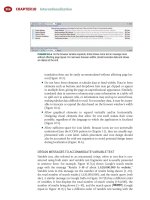iPhone Design Award-Winning Projects ppt
Bạn đang xem bản rút gọn của tài liệu. Xem và tải ngay bản đầy đủ của tài liệu tại đây (42.12 MB, 217 trang )
Dannen
iPhone Design Award-Winning Projects
Companion
eBook
Available
iPhone Design
Award-Winning Projects
Chris Dannen
Trim: 7.5 x 9.25 spine = 0.59375" 216 page count
The nuts, bolts and philosophy behind some
of the iPhone’s most elegant and innovative apps
COMPANION eBOOK SEE LAST PAGE FOR DETAILS ON $10 eBOOK VERSION
US $39.99
Shelve in
Mobile Computing
User level:
All
www.apress.com
SOURCE CODE ONLINE
BOOKS FOR PROFESSIONALS BY PROFESSIONALS
®
this print for content only—size & color not accurate
CYAN
MAGENTA
YELLOW
BLACK
PANTONE 123 C
SPOT VARNISH
ISBN 978-1-4302-7235-9
9 781430 272359
5 39 9 9
i
Phone Design Award-Winning Projects proles developers receiving the pres-
tigious Apple Design Awards for iPhone app excellence. You’ll learn what
makes these apps stand out, including explanations of great user interface
design and implementation. You’ll also get a look at the code under the hood,
and how these apps were engineered to be some of the most responsive, in-
tuitive, useful, and just plain fun apps running on the iPhone.
In addition, each prole is paired with an interview of a leading developer recognized
for excellence in iPhone app design and execution. This includes such Mac and iPhone
luminaries as:
•
Joe Hewitt of Facebook, paired with Loren Brichter of atebits, discussing
innovation in iPhone User Interface Design;
•
foursquare’s Dennis Crowley and Naveen Selvadurai, paired with ngmoco:)’s
Bob Stevenson and Allen Ma, creating connected, interactive gaming fun;
•
Jonathan and Ashley Wegener of JWeg Ventures, paired with Dave Witonsky
and Randall Barnhart of Intermap, tting huge data les into ecient geo-
based apps;
•
Wil Shipley of Delicious Monster, paired with Chris Parrish and Brad Ellis of
Rogue Sheep, building complex user interface elements with OpenGL and a
watchful eye on Memory Management;
•
Zachary West of Prowl, paired with Elias Pietilä of Qvik, magically transforming
big ideas into highly-focused, compelling user experiences; and
•
a bonus grouping of three super-luminaries, Ge Wang of Smule, Alykhan Jetha
and Brandon Walkin of Marketcircle, and leading blogger, Marco Arment of
Tumblr and Instapaper, philosophize on the intangible qualities of making
better apps that enfranchise iPhone users.
You’ll also learn
•
how detail-oriented designers create great-looking interfaces that go beyond
mere user-friendliness;
•
how obsessive programmers optimize every line of Objective-C, while
simultaneously eliminating bugs; and
•
how inspiration strikes at unlikely times and in unlikely places—and how to
use it to plan for success.
This book is for
All iPhone and iPod touch developers seeking enlightenment from recognized app
design gurus.
RELATED TITLES
i
iPhone Design
Award-Winning Projects
■ ■ ■
Chris Dannen
ii
iPhone Design Award-Winning Projects
Copyright © 2009 by Chris Dannen
All rights reserved. No part of this work may be reproduced or transmitted in any form or by any means, electronic
or mechanical, including photocopying, recording, or by any information storage or retrieval system, without the
prior written permission of the copyright owner and the publisher.
ISBN-13 (pbk): 978-1-4302-7235-9
ISBN-13 (electronic): 978-1-4302-7234-2
Printed and bound in the United States of America 9 8 7 6 5 4 3 2 1
Trademarked names may appear in this book. Rather than use a trademark symbol with every occurrence of a
trademarked name, we use the names only in an editorial fashion and to the benefit of the trademark owner, with
no intention of infringement of the trademark.
President and Publisher: Paul Manning
Lead Editors: Clay Andres
Developmental Editor: Douglas Pundick
Technical Reviewer: Joachim Bondo
Editorial Board: Clay Andres, Steve Anglin, Mark Beckner, Ewan Buckingham, Gary Cornell, Jonathan Gennick,
Jonathan Hassell, Michelle Lowman, Matthew Moodie, Duncan Parkes, Jeffrey Pepper, Frank Pohlmann,
Douglas Pundick, Ben Renow-Clarke, Dominic Shakeshaft, Matt Wade, Tom Welsh
Coordinating Editor: Kelly Moritz
Copy Editor: Tracy Brown Collins
Compositor: MacPS, LLC
Indexer: BIM Indexing and Proofreading Services
Artist: April Milne
Cover Designer: Anna Ishchenko
Distributed to the book trade worldwide by Springer-Verlag New York, Inc., 233 Spring Street, 6th Floor, New York,
NY 10013. Phone 1-800-SPRINGER, fax 201-348-4505, e-mail , or visit
.
For information on translations, please e-mail , or visit .
Apress and friends of ED books may be purchased in bulk for academic, corporate, or promotional use. eBook
versions and licenses are also available for most titles. For more information, reference our Special Bulk Sales–
eBook Licensing web page at
The information in this book is distributed on an “as is” basis, without warranty. Although every precaution has
been taken in the preparation of this work, neither the author(s) nor Apress shall have any liability to any person or
entity with respect to any loss or damage caused or alleged to be caused directly or indirectly by the information
contained in this work.
iii
iv
Contents at a Glance
■Contents at a Glance iv
■Contents v
■About the Author vii
■About the Technical Reviewer viii
■Acknowlegments ix
■Introduction x
Part I: Innovating Beyond Apple’s Design Standards, While Maintaining Apple’s Logic
for Consistency, Clarity, and Usability 1
■Chapter 1: Tweetie 3
■Chapter 2: Facebook 23
Part II: Using App Connectivity with Core Location to Make Games Social 33
■Chapter 3: Topple 2 35
■Chapter 4: Q&A: Foursquare 53
Part III: Using Compression to Cram More Data into a Local App– Large Images,
Geo Data, and Lots of It 63
■Chapter 5: AccuTerra 65
■Chapter 6: Q&A: Exit Strategy NYC 81
Part IV: Creating a Beautiful App Without Falling Victim to Memory Issues—OpenGL,
Skinning, Object Reuse, and Coding Efficiently 91
■Chapter 7: Postage 93
■Chapter 8: Q&A: Delicious Library 109
Part V: Fitting a Big Idea into a Small Space – Keeping the Feature List Focused,
Simple, Refined, and Compelling 121
■Chapter 9: Wooden Labyrinth 3D 123
■Chapter 10: Q&A: Prowl 133
Part VI: Making Better Apps and Enfranchising Your Users – The Right Way to Iterate,
Planning an App Store Strategy, and Some Serious iPhone Development Philosophy 143
■Chapter 11: User Experience: Ge Wang 145
■Chapter 12: Iterative Design 155
■Chapter 13: Upgrading 181
■Index 191
v
Contents
■Contents at a Glance iv
■Contents v
■About the Author vii
■About the Technical Reviewer viii
■Acknowledgments ix
■Introduction x
Part I: Innovating Beyond Apple’s Design Standards, While Maintaining
Apple’s Logic for Consistency, Clarity, and Usability 1
■Chapter 1: Tweetie 3
A Billion Bad Twitter Apps 4
The Minimalist Flourish 7
Tearing Down Tweetie 12
Organic Marketing 13
Tweetie 2 17
Market Share 20
■Chapter 2: Facebook 23
Part II: Using App Connectivity with Core Location to Make Games Social 33
■Chapter 3: Topple 2 35
How to Do a Sequel: Conceptually 36
How to Do a Sequel: Technically 39
Designing Apps (and Companies) for the Mass Market 44
Managing a Universe 45
PVRTC-It 45
Fun, the Apple Way 47
Bureaucracy and Lightheartedness 49
Free vs. Paid 50
■Chapter 4: Q&A: Foursquare 53
vi
Part III: Using Compression to Cram More Data into a Local App–
Large Images, Geo Data, and Lots of It 63
■Chapter 5: AccuTerra 65
Building a Framework 66
Divide and Conquer 68
Building an In-App Store 70
PVRTC or Broke 72
Lazy Loading 73
Memory Diagnostics: Sample Project 74
Dealing with Low Memory Warnings 76
Building Forward 78
■Chapter 6: Q&A: Exit Strategy NYC 81
Part IV: Creating a Beautiful App Without Falling Victim to Memory
Issues—OpenGL, Skinning, Object Reuse, and Coding Efficiently 91
■Chapter 7: Postage 93
There Were Sheep 94
Is This One of Them Internets? 95
Coding for Fun 97
The Circling Shark 100
Homegrown Design 102
Building On Postage 107
■Chapter 8: Q&A: Delicious Library 109
Part V: Fitting a Big Idea into a Small Space – Keeping the Feature
List Focused, Simple, Refined, and Compelling 121
■Chapter 9: Wooden Labyrinth 3D 123
The Dropout 125
The Challenge 127
Building the Labyrinth 129
The “Magic” Piece 130
Into the Fray 131
■Chapter 10: Q&A: Prowl 133
Part VI: Making Better Apps and Enfranchising Your Users –
The Right Way to Iterate, Planning an App Store Strategy,
and Some Serious iPhone Development Philosophy 143
■Chapter 11: User Experience: Ge Wang 145
■Chapter 12: Iterative Design 155
The Canadian Way 156
Simply Complex 158
Group Single-mindedness 162
Reverse Engineering Cocoa 165
The Sidebar Solution 171
Enter the iPhone 174
Project Yellow Canary 177
■Chapter 13: Upgrading 181
■Index 191
vii
About the Authors
Chris Dannen is a writer specializing in technology and innovation. He writes primarily for
FastCompany magazine and Bnet.com, where he covers software, mobile technology, Web,
mapping and all things Apple. He is also co-author of Google Voice For Dummies (Wiley,
2009). Chris received his BA from the University of Virginia and lives in the Williamsburg
section of Brooklyn, NY.
viii
About the Technical Reviewer
Joachim Bondo has developed software for three decades, from programmable calculators in
the late ’70s before computers were commonly available, to now the iPhone.
After releasing Deep Green, his critically acclaimed chess application, on the App Store,
Joachim has contributed his excellent taste and insight on good user interface design to
several Apress titles: iPhone Games Projects, iPhone Advanced Projects, iPhone User Interface
Design Projects, and now iPhone Design Award-Winning Projects.
ix
Acknowledgments
A great deal of gratitude is due to all the developers who sat for interviews in order to contribute to this book. Their
patience, expertise and colorful explanations make this book what it is.
Special thanks to the developers who answered my incessant questions with extra detail, and took the time to
explain ancillary concepts, code and hypotheticals at great length: Jonathan Wegener, Loren Brichter, Brandon
Walkin and AJ of Marketcircle; Dave Witonsky for his enthusiasm and Marco Arment for one giant cup of green tea.
Thanks also to Clay Andres for his perennial guidance, and Kelly Moritz, Douglas Pundick, Tracy Brown Collins,
and Joachim Bondo for their hard work and careful consideration. Many thanks also to Austin Carr, whose quick
transcriptions saved me from the woes of carpal tunnel.
Finally, thanks to my editors at FastCompany, Noah Robischon and Lynne d Johnson particularly, for
accommodating the crazed schedule I adopted while writing this book.
x
Introduction
Readme
This is a book about building apps with good design, parsimonious code and aesthetic appeal on the Apple iPhone
and iPod Touch. At times, this book references code and give sample projects; other times, it delves into interaction
and visual design. It doesn’t take a CS doctorate to appreciate or even understand, but some familiarity with
programming is assumed.
Who is this book for?
Lots of people. Mac developers looking to do a killer iPhone app might want to know the hard-won lessons or
philosophies of others; iPhone hackers looking to step up their game might be trying to figure out how much to
emulate Apple. Anyone who appreciates a success story will hopefully enjoy this book, but it’s also inspirational.
How technical is it?
Parts of this book assumes basic knowledge of C or other object-oriented programming languages. In some cases,
we reference specific Apple frameworks and interface guidelines. It will also help to be familiar with the Apple
environment, from the quirks of the App Store to technologies inside OS X.
How were these interviewees chosen?
The five core chapters of this book are based on a series of interviews with five of the 2009 winners of Apple Design
Awards (ADAs) for the iPhone. MLB.com, the makers of the sixth ADA winner, MLB.com at Bat, did not consent to
be interviewed for this book in order to protect their intellectual property.
The remaining six developers interviewed for this book were chosen by its writer and editors because they
buttressed some of the discussions in the core chapters, or because they provided a contrasting philosophy to
another developer in the book. It was important not only that these six apps use Apple frameworks competently,
but that they also smartly navigated the App Store, its frenetic marketplace, and its fickle economy.
Speaking of money: this book also aims to address the philosophies behind monetizing (or not monetizing) an app.
How do I set an optimal price? Should my app be free? How about the upgrade? What are the risks of in-app
purchasing? It’s not as much fun as talking about code or UI, but sometimes monetization means the difference
between designing the app you want, or compromising to cover your overhead.
xi
Lastly, this book tries to garner thoughts and opinions from developers building a wide variety of software. Several
of the apps highlighted herein are tied into desktop companion apps or websites; others discuss the construction
and revision of sequels. Some of the developers themselves aim to startup iPhone-only shops, while some are
veteran Mac developers or new-to-Apple developers looking to experiment. But they’re all motivated by a single
question: how do I build a better iPhone app in concept and in practice?
Chris Dannen
xii
1
Part
Innovating Beyond
Apple’s Design Standards,
While Maintaining Apple’s
Logic for Consistency,
Clarity, and Usability
With over 100,000 apps in the App Store, how have Facebook and Tweetie managed to
rise above the rabble? Used by millions of iPhone owners and accessed just as often as
many of Apple’s native apps, both these social network clients wield incredible
influence, not only over their users, but also over the way UI standards come to be
accepted by the iPhone masses in general. These are no normal apps. They are apps
that help make the platform.
Tweetie and Facebook are incredibly deep and beautifully-engineered pieces of
software. The two are made for very different use Tweetie is borne of singular purpose,
while Facebook is evolving to be a Swiss Army app but they are alike in one particular
trait: personality. Both developers have crafted their vision of iPhone UI with stubborn
confidence, but also even-handedness. Where they believe Apple has shown ingenuity,
they pay competent homage. But where they believe Apple has lapsed, they gladly pick
up the pace of innovation and carry it forward.
This is no small assumption on an Apple device, which, like other Apple products, has
come to vaunt its remarkable ease of use and its long, careful development as the
reasons for its success. Loren Brichter and Joe Hewitt, the developers featured in this
section, don’t seem worried. It’s a combination of humility and precociousness that
could only be called Jobsian.
I
2
3
3
Chapter
Tweetie
Developer name: Loren Brichter
Development Company: Atebits
Tags: Layout; Efficient Code; Workflow
URL:
“I can’t go into details because I think everything is under NDA for, like, the next 20
years,” says Loren Brichter, the founder and sole developer at Philadelphia-based
Mac shop atebits, and developer of Tweetie (Figure 1–1). He’s talking about the
top-secret program he worked on at Apple: the iPhone.
Figure 1–1. Tweetie’s innovative UI won it a cult following.
1
CHAPTER 1: Tweetie
4
He stayed for a year—the most exciting year of his life, by his own account. But having
grown up on Manhattan’s Upper West Side and gone to Tufts University in Boston,
Brichter was a Right Coast kid and he couldn’t stay away. He moved back East, sat
down, and did the only thing he knew how to do: he wrote a Mac app.
“My first product was a little drawing app called Scribbles,” he says. “It kept me a live, it
made a little bit of money, but it wasn’t hugely successful.” He was good with Cocoa
and OpenGL; the projects that had gotten him hired at Apple were an iTunes visualizer
and a soft-body physics simulator. Once assigned to the iPhone project, he had worked
in the guts of Cocoa, at the UIKit level and below. He was a programmer’s programmer.
So it was no surprise that when he first signed up for Twitter in November 2007, he was
more or less disgusted by the brevity of 140-character tweets. “I signed up, used it for
five minutes, and decided: this is stupid,” he says.
It would be a year before he started using it again, to keep up with the tweets of tech
pundit John Gruber. Why? “Gruber is interesting guy,” Brichter says. He found there
were actually lots of other interesting guys on Twitter. “People joke about Twitter, that
it’s stupid and superficial,” Brichter says. “And if you follow superficial people, it’s
superficial. But if you follow interesting people, it’s interesting.”
A Billion Bad Twitter Apps
It was around the same time that his Verizon Wireless contract expired and he finally got
an iPhone. He started scouring the App Store. “I realized there are no good Twitter
apps,” he recalls. “But there are a billion bad ones.” He figured he could probably write
a better app. “What triggered me to do it? I was playing with Twitterific, which I used,
and everybody used. I thought: I wonder why the scrolling is so slow? I wonder if I can
make it faster.” In an hour, he had built a prototype of a list of fast-scrolling tweets.
Then, after a two-week paroxysm of coding, he had built Tweetie, shown in Figure 1–1,
which is as of this writing the most popular mobile Twitter client on any platform, and the
most popular Twitter app for iPhone.
Brichter attributes Tweetie’s meteoric rise in popularity to a cocktail of luck, quality
programming, and some well-timed publicity. But what really lives at the core of his
success—and Tweetie’s—is an absolute intolerance for mediocrity. “I have a shit-list of
Twitter apps that just drive me insane,” he says. “Apple lays out all these guidelines and
conventions about how to write an iPhone app, and these developers basically looked at
them and did the exact opposite in every single case.”
He’s not looking for perfection, however—just parsimony. If it’s one concept of design
and interaction that gets Brichter excited, it’s economy of energy, be it in actual usage
scenarios or in software development. Ask him what aggravated him about the existing
selection of Twitter apps back in November of 2008, when he wrote Tweetie, and he
doesn’t talk about their ugliness or their complexity. Even the slowness that bugged him
in Twitterific is merely a symptom of flawed thinking. “The problem isn’t with how the
other apps used Twitter’s API, it’s with the way they interacted with the iPhone OS,” he
says. “Either they were doing something completely custom, or completely wrong.” His
antipathy wasn’t even aimed at Twitterific, though it was the immediate catalyst for
CHAPTER 1: Tweetie
5
Tweetie. “To tell you the truth, I didn’t have a lot of beef with Twitterific,” he says. “They
were the ADA winner from the year before, and everyone loved the app. It just didn’t jibe
with the way I used Twitter.”
It’s not that Brichter is a loyal Apple devotee, either; he has beef with plenty of the native
apps. “On the SMS app, the ‘Send’ button is right next to the keyboard,” he quibbles,
“so you hit it accidentally. There’s no reason they couldn’t have put it up in the nav bar.”
Mail too was a cautionary tale for Tweetie. “Everything in Mail is twice as many taps [as
with Tweetie]. You have the account list, then the folder list, and then you get into the
message list,” he says. “I want to be able to go into an inbox with one tap, not two or
three.” (Figure 1–2 shows the first tweet feed prototype; Figure 1–3 shows a second
iteration.)
Figure 1–2. The first Tweetie fast-scrolling prototype.
Download at WoweBook.com
CHAPTER 1: Tweetie
6
Figure 1–3. Another scrolling iteration, this one more iChat-inspired.
The atebits way of using something, distilled, is the pursuit the path of least resistance.
“I got lucky, because the way I originally wrote Tweetie made sense in terms of how you
should interact with a Twitter app,” he says. His idea of how a user “should” use Twitter
is based the navigation Apple Mail, made better: each tap in a tweet’s menu pushes you
rightward into a deeper folder. That’s how Tweetie manages to pack in Recent Tweets,
Search @, Following, Followers, and Block/Unblock without a mess of buttons or
oddball menus. “It doesn’t seem complicated—that’s how every Twitter app should
work,” he says. “But yet that’s not how Twitter apps work.”
The most popular functions aren’t made available through more buttons, or more
menus—just swipe, as if you’re deleting an email or a text, and you have the ability to
star, @reply, or see the profile of the user whose tweet you’re investigating (though you
can also do this by clicking a tweet, if you’re not aware of the shortcut). “My philosophy
was: don’t fight the framework,” he says. “UI Kit APIs are so insanely beautiful that you
can pick them up super-fast, even if you don’t know how to program. It provides all this
awesome functionality, but all these other apps do things their own custom way. But if
you just embrace the UI Kit philosophy, you can build an app like Tweetie really fast.”
(Figure 1–1 shows the swipe shortcut.)
Easy for the ex-Apple iPhone wonk to say, right? Well, sort of. “At Apple I didn’t do any
app stuff except some performance tuning for other teams—making apps faster, doing
CHAPTER 1: Tweetie
7
some fancy looking transitions. I didn’t really have any app building experience at all, so
when I sat down to start writing Tweetie, I was learning the process from scratch.”
The Minimalist Flourish
While Brichter might have a thing for parsimony, the fine-tuning he did during his year at
Apple is readily apparent in both Tweetie and Scribbles in a handful of beautiful actions.
Make a command—a new document or tweet, or the preferences pane—and the
window slips out from under the menu bar with a flourish, in a kind of reverse-genie
effect inspired by the dock. Things in both apps move uncannily fast; even on a dual-
core Macs where waiting is a rarity, the file browser practically rockets out of a tweet’s
title bar. Atebits apps are compact, purpose-built and deceptively robust, like race-
tuned Mini Coopers of the Cocoa realm. (Figure 1–4 shows a tweet in the making, using
Tweetie for Mac.)
Figure 1–4. Tweetie for Mac, which uses the same codebase as Tweetie 2 for iPhone, contains subtle, rapid
animations.
Economy of design is often accompanied by minimalism, and Brichter’s work style is
fittingly Spartan. He doesn’t use Interface Builder; all of Tweetie versions 1 and 2 were
built programmatically in Xcode. And unlike most of the Mac developers in this book,
uses just one machine and just one screen. “A few months ago I got a 17-inch MacBook
Pro, and my Mac Pro has been in storage ever since,” he says. It took Brichter just five
days of coding to build the Twitter-iPhone core inside Tweetie 1, a few days doing the
user interface, and a few more in the hands of beta testers; the whole app weighed in at
30,000 lines of code.
CHAPTER 1: Tweetie
8
It is perhaps because of Twitter’s straightforwardness that Brichter’s Tweetie project
makes for such an excellent example for developers. Unlike most apps, Tweetie has the
benefit (and the onus) of an extant paradigm: the Web version of Twitter The extent to
which Tweetie (or any Twitter iPhone app) succeeds is based largely on one question:
how much additional cognitive load will it take me to use Twitter using this app instead
of the Web?
To give Tweetie parity with the Web experience, Brichter first built in all the features an
average user would want, but he didn’t stop there; he lets power-users navigate reply
chains, upload pictures to Twitpic.com, view trends, do searches, search nearby users
using the phone’s A-GPS, and even built a bookmarklet that users can deploy in mobile
Safari to send links to Tweetie. In 1.2, the first major feature update of release, he added
Instapaper support, landscape keyboard, image compression control for Twitpic
uploads, those Mail-like swipe shortcuts, stock quote links, and the ability to forward
direct messages to email (for more on Instapaper, see Chapter 13). If you’re a Twitter
Web user, you know that a whole lot of those features don’t even appear anywhere on
Twitter itself.
So features he had in spades—but having tons of features is often anathema to
usability. Since it was Twitterific’s slow scrolling that compelled him to build Tweetie in
the first place, Brichter first set out to invent a new way the iPhone rendered its table
cells. Most apps—in accordance Apple’s own tutorials—force the phone to render a
morass of subviews of labels and images, but Brichter’s code pre-blends everything
together using CoreGraphics. Once it renders that first frame, it hands one opaque static
view over to CoreAnimation without the need to rely on the GPU to do any blending
Brichter was so convinced that his fast-scrolling code was superior to Apple’s that he
posted a tutorial on his web site, where he makes his case: “If you think about what is
happening in terms of overdraw, having one big view per table cell is a big win, because
CoreAnimation will only touch a single given pixel on the screen once rather than
multiple times (potentially, depending on how much overlap your old view hierarchy
had),” he wrote.
1
As with Tweetie, Brichter’s sample project relies on just one class of object for
everything: ABTableViewCell.h and ABTableViewCell.m. In Listing 1–1, he creates a
sample list of words with a first- and last-name field in two separate fonts as in the
Contacts app.
List 1–1. Creating a first- and last-name field
//
// FirstLastExampleTableViewCell.m
// FastScrolling
//
// Created by Loren Brichter on 12/9/08.
// Copyright 2008 atebits. All rights reserved.
//
#import "FirstLastExampleTableViewCell.h"
1
CHAPTER 1: Tweetie
9
@implementation FirstLastExampleTableViewCell
@synthesize firstText;
@synthesize lastText;
static UIFont *firstTextFont = nil;
static UIFont *lastTextFont = nil;
+ (void)initialize
{
if(self == [FirstLastExampleTableViewCell class])
{
firstTextFont = [[UIFont systemFontOfSize:20] retain];
lastTextFont = [[UIFont boldSystemFontOfSize:20] retain];
// this is a good spot to load any graphics you might be drawing in -
drawContentView:
// just load them and retain them here (ONLY if they're small enough
that you don't care about them wasting memory)
// the idea is to do as LITTLE work (e.g. allocations) in -
drawContentView: as possible
}
}
- (void)dealloc
{
[firstText release];
[lastText release];
[super dealloc];
}
// the reason I don't synthesize setters for 'firstText' and 'lastText' is because I
need to
// call -setNeedsDisplay when they change
- (void)setFirstText:(NSString *)s
{
[firstText release];
firstText = [s copy];
[self setNeedsDisplay];
}
- (void)setLastText:(NSString *)s
{
[lastText release];
lastText = [s copy];
[self setNeedsDisplay];
}
- (void)drawContentView:(CGRect)r
{
CGContextRef context = UIGraphicsGetCurrentContext();
UIColor *backgroundColor = [UIColor whiteColor];
UIColor *textColor = [UIColor blackColor];
if(self.selected)
CHAPTER 1: Tweetie
10
{
backgroundColor = [UIColor clearColor];
textColor = [UIColor whiteColor];
}
[backgroundColor set];
CGContextFillRect(context, r);
CGPoint p;
p.x = 12;
p.y = 9;
[textColor set];
CGSize s = [firstText drawAtPoint:p withFont:firstTextFont];
p.x += s.width + 6; // space between words
[lastText drawAtPoint:p withFont:lastTextFont];
}
@end
ABTableViewCell.m reads:
#import "ABTableViewCell.h"
@interface ABTableViewCellView : UIView
@end
@implementation ABTableViewCellView
- (void)drawRect:(CGRect)r
{
[(ABTableViewCell *)[self superview] drawContentView:r];
}
@end
@implementation ABTableViewCell
ABTableViewCell.h reads:
#import <UIKit/UIKit.h>
// to use: subclass ABTableViewCell and implement -drawContentView:
@interface ABTableViewCell : UITableViewCell
{
UIView *contentView;
}
- (void)drawContentView:(CGRect)r; // subclasses should implement
@end
CHAPTER 1: Tweetie
11
RootConroller.m reads:
//
// RootViewController.m
// FastScrolling
//
// Created by Loren Brichter on 12/9/08.
// Copyright atebits 2008. All rights reserved.
//
#import "RootViewController.h"
#import "FastScrollingAppDelegate.h"
#import "FirstLastExampleTableViewCell.h"
@implementation RootViewController
- (void)viewDidLoad
{
self.title = @"Fast Scrolling Example";
[super viewDidLoad];
}
- (NSInteger)tableView:(UITableView *)tableView numberOfRowsInSection:(NSInteger)section
{
return 100;
}
static NSString *randomWords[] = {
@"Hello",
@"World",
@"Some",
@"Random",
@"Words",
@"Blarg",
@"Poop",
@"Something",
@"Zoom zoom",
@"Beeeep",
};
#define N_RANDOM_WORDS (sizeof(randomWords)/sizeof(NSString *))
- (UITableViewCell *)tableView:(UITableView *)tableView
cellForRowAtIndexPath:(NSIndexPath *)indexPath
{
static NSString *CellIdentifier = @"Cell";
FirstLastExampleTableViewCell *cell = (FirstLastExampleTableViewCell
*)[tableView dequeueReusableCellWithIdentifier:CellIdentifier];
if(cell == nil)
{
cell = [[[FirstLastExampleTableViewCell alloc]
initWithStyle:UITableViewCellStyleDefault reuseIdentifier:CellIdentifier] autorelease];
}
cell.firstText = randomWords[indexPath.row % N_RANDOM_WORDS];
cell.lastText = randomWords[(indexPath.row+1) % N_RANDOM_WORDS];









